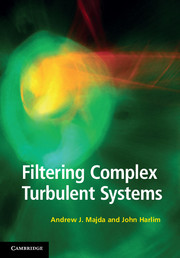Book contents
- Frontmatter
- Contents
- Preface
- 1 Introduction and overview: Mathematical strategies for filtering turbulent systems
- Part I Fundamentals
- Part II Mathematical guidelines for filtering turbulent signals
- Part III Filtering turbulent nonlinear dynamical systems
- 9 Strategies for filtering nonlinear systems
- 10 Filtering prototype nonlinear slow–fast systems
- 11 Filtering turbulent nonlinear dynamical systems by finite ensemble methods
- 12 Filtering turbulent nonlinear dynamical systems by linear stochastic models
- 13 Stochastic parametrized extended Kalman filter for filtering turbulent signals with model error
- 14 Filtering turbulent tracers from partial observations: An exactly solvable test model
- 15 The search for efficient skillful particle filters for high-dimensional turbulent dynamical systems
- References
- Index
15 - The search for efficient skillful particle filters for high-dimensional turbulent dynamical systems
from Part III - Filtering turbulent nonlinear dynamical systems
Published online by Cambridge University Press: 05 March 2012
- Frontmatter
- Contents
- Preface
- 1 Introduction and overview: Mathematical strategies for filtering turbulent systems
- Part I Fundamentals
- Part II Mathematical guidelines for filtering turbulent signals
- Part III Filtering turbulent nonlinear dynamical systems
- 9 Strategies for filtering nonlinear systems
- 10 Filtering prototype nonlinear slow–fast systems
- 11 Filtering turbulent nonlinear dynamical systems by finite ensemble methods
- 12 Filtering turbulent nonlinear dynamical systems by linear stochastic models
- 13 Stochastic parametrized extended Kalman filter for filtering turbulent signals with model error
- 14 Filtering turbulent tracers from partial observations: An exactly solvable test model
- 15 The search for efficient skillful particle filters for high-dimensional turbulent dynamical systems
- References
- Index
Summary
In Chapters 9 and 11 we discussed finite ensemble filtering of nonlinear dynamical systems with Kalman-based (or linear) techniques and we demonstrated their advantages in the less turbulent regime and their limitation in the sparsely observed fully turbulent regime. We also showed their sensitivity toward variations of filtering parameters such as the variance inflation and ensemble size. Subsequently in Chapters 12–14, we discussed alternative strategies based on cheap reduced stochastic models to avoid all the disadvantages of ensemble Kalman filtering strategies and demonstrated their skill for filtering various turbulent nonlinear systems ranging from the idealized toy models like L-96 to quasi-geostrophic turbulence to turbulent diffusion models with non-Gaussian statistics.
Recently, there is an emerging need to develop nonlinear filtering methods beyond the ensemble Kalman filters since most physical problems are nonlinear and sometimes have highly non-Gaussian distributions. One of the most difficult problems is to devise a practically useful ensemble method based on the theoretically well-established particle filtering (or sequential Monte Carlo) methods (Del Moral, 1996; Del Moral and Jacod, 2001; Doucet et al., 2008). The major challenge is to have a particle filter that is practically skillful for high-dimensional complex turbulent systems with only small ensemble size (small number of particles); this is very important because of the large overload in generating individual ensemble members through the forward dynamical operator (Haven et al., 2005).
- Type
- Chapter
- Information
- Filtering Complex Turbulent Systems , pp. 316 - 348Publisher: Cambridge University PressPrint publication year: 2012



